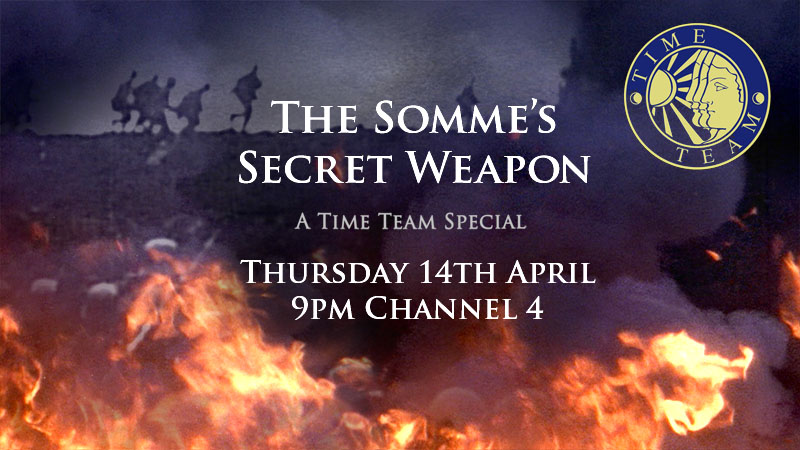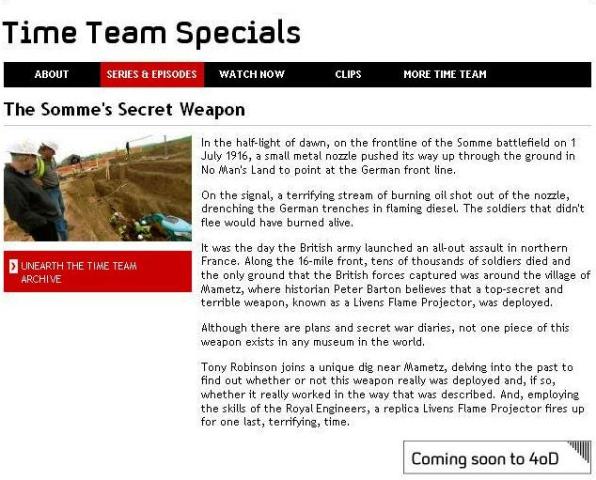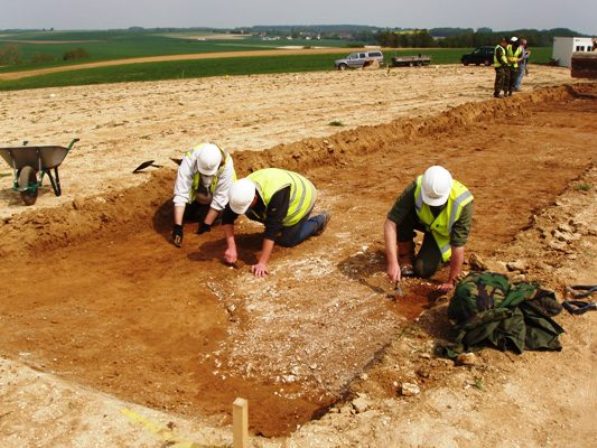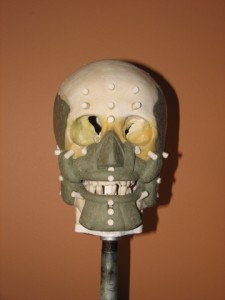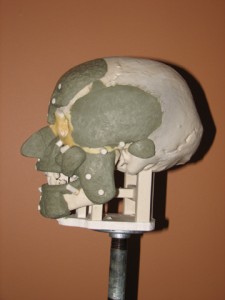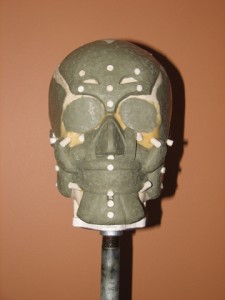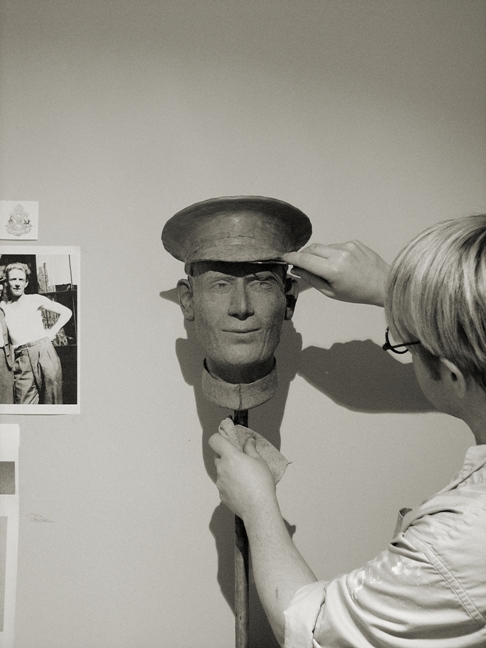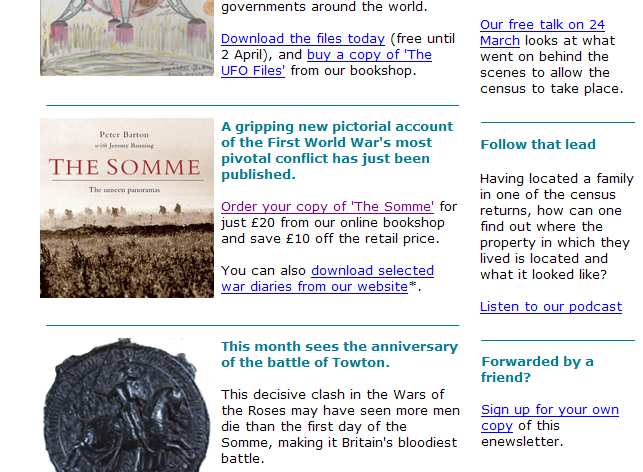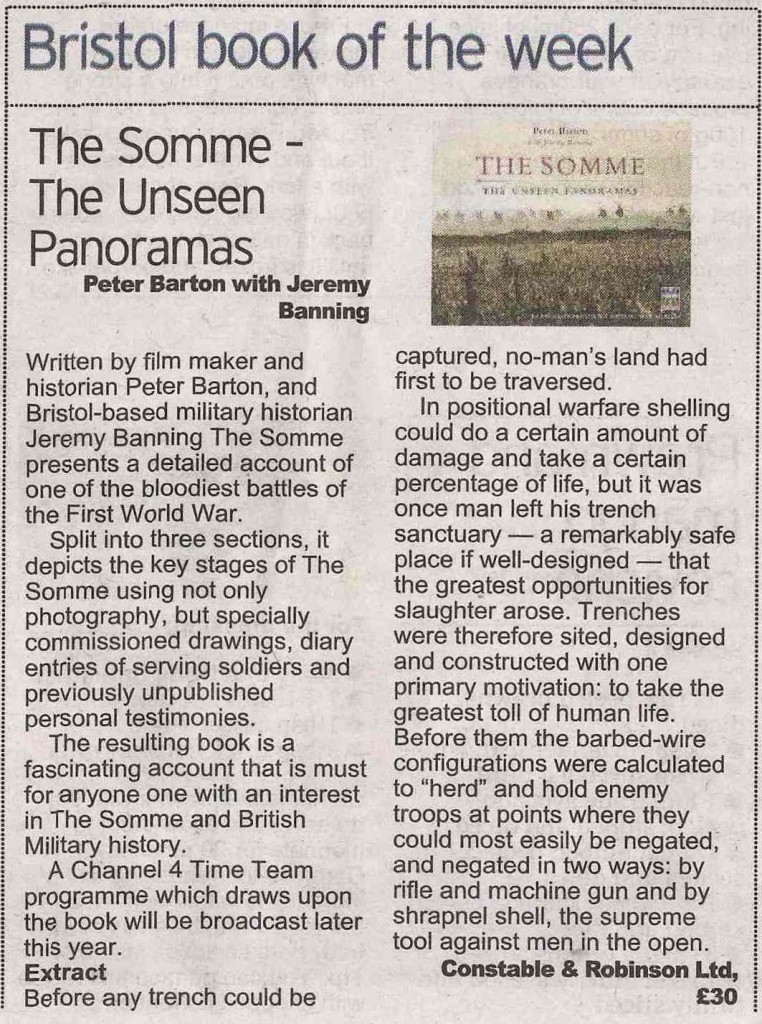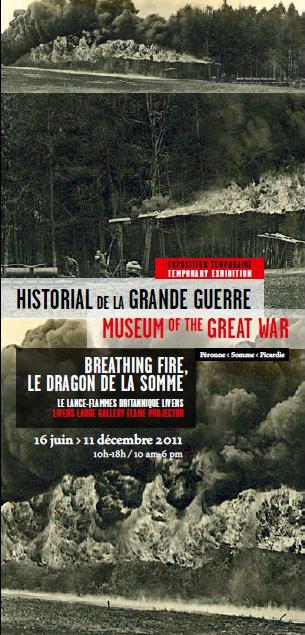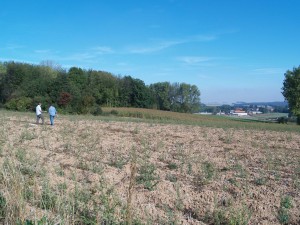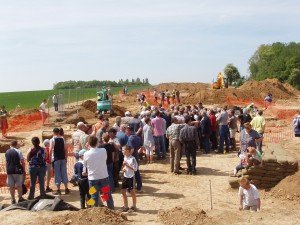Posts Tagged ‘WW1’
I was contacted by the Canadian Portrait Academy (CPA) when I first wrote a blog entry on the positive identification of Thomas Lawless. I initially saw news of this via my Twitter feed and realised what a good news story it was. I like to keep tabs on ‘news from the front’ and knew that this story fitted the bill perfectly. Little did I know the interest it would generate. Since that first post I have been heartened by the enthusiasm and generosity of those involved in the process to share their time and material so willingly.
The CPA have been wonderful in keeping me up to date with events and, through them, I have made contact with Christian Corbet, the sculptor who worked as the Forensic Artist with the Department of National Defence and others to reconstruct a likeness of Thomas Lawless.
Mr Corbet has kindly agreed to let me post images of his work on the facial reconstruction process. These photos are copyright and reproduced by kind permission of Christian Corbet. They show a few of the stages in the reconstruction process and are clear evidence of the levels of technical quality employed.
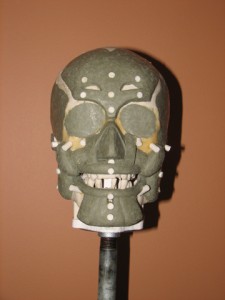
Facial reconstruction of Thomas Lawless 4 - muscles are placed on the skull, Copyright by Permission of Christian Corbet
The facial reconstruction procedure was the initial stage in the identification process and the end result (the sculpture) was used by Dr Andrew Nelson of the University of Western Ontario for computer superimpositions in order to identify the subject. Dr Nelson began his work on this particular identification process in 2007. The condition of the remains meant that Dr Nelson reconstructed the bony part of the midface in epoxy resin and a computer model of the skull was then made. A three dimensional print using bone fragments and photographic superimposition (for the midface) was then created.
This gave Christian Corbet the base to work from for a forensic reconstruction of the face (as shown in the photographs). The team had photos of all the proposed subjects and so a comparison could be made between the sculpture and photos. By eliminating those whose facial characteristics did not match, the shortlist was reduced to two soldiers – one from Cape Breton and the other from Ireland. It was at this stage that that Dr. Nelson suggested isotope analysis – the method by which the Irishman, Thomas Lawless was eventually identified. As Christian Corbet wrote to me, this multidisciplinary collaborative project is said to be a first of its kind in identifying a soldier of the Great War. I think that it is the model for future studies and shows what can be done with available resources, time and skilled personnel.
Mr Corbet’s protégé Benjamin Trickett Mercer told me that the 3-dimensional sculpture of Thomas Lawless took approximately 5 days to complete. It is estimated that approximately 25 – 30 hours were spent on finishing the formal portrait. Help regarding the accoutrements of a Great War soldier were provided by the costume department of the Canadian War Museum. This ensured that the correct regimental badges could be sculpted. They even assisted in the providing the essential but easily overlooked measurements for the size of the soft cap.
Burial – 15 March 2011
Mr Corbet and Benjamin Trickett Mercer attended the burial service on 15 March 2011. Mr Corbet had the honour to place flowers on the grave of Thomas Lawless on behalf of the Province of Newfoundland and Labrador.
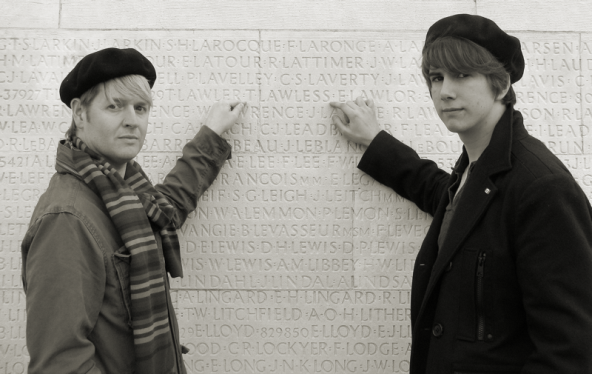
Christian Corbet and his protégé Benjamin Trickett Mercer pointing to the name of Thomas Lawless at the Vimy Memorial. Copyright by Permission of Christian Corbet
On the same note, I received a Press Release earlier from the CPA. It is shown below in italics along with the photograph.
Newfoundland and Labrador Presents Floral Tribute to Fallen WWI Soldier
Avion, France – In an act of respect the province of Newfoundland and Labrador paid homage with a floral bouquet at the burial of Pte. Thomas Lawless on 15th March in Avion, France.
Premier Dunderdale granted permission to Christian Corbet an Academician of the Canadian Portrait Academy to lay flowers of white lilies and red roses upon the grave of Pte. Lawless. Pte. Lawless’ fought at the Battle of Vimy Ridge and his identity was recently released after he went missing in action in June 1917.
This floral tribute was the only one presented from a province or territory from Canada.
Christian Corbet who worked as the Forensic Artist with the Department of National Defence among other institutions in order help identify the remains of the World War I soldier stated “This bouquet of flowers was Newfoundland and Labradors way of saying “Thank You for laying your life down for the freedom we so often take for grated today.” The Irish descendants of Pte. Thomas Lawless were greatly appreciative and grateful for such a kind gesture.”

Christian Corbet presented a floral tribute to fallen WWI soldier on behalf of the Province of Newfoundland and Labrador at La Chaudiere Military Cemetery, France. Photo Credit: Benjamin Trickett Mercer, CPA.
For more information on the burial: http://www.cmp-cpm.forces.gc.ca/dhh-dhp/adh-sdh/news-nouvelle-eng.asp
Please find below some more photos of the burial service, courtesy of Christian Corbet.
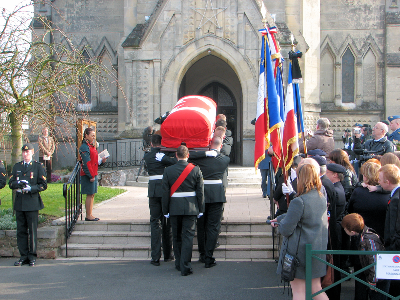
The coffin of Thomas Lawless is carried into the church of Saint-Martin de Vimy. Copyright by Permission of Christian Corbet

Canadian armed forces and standard bearers at the funeral service of Thomas Lawless. Copyright by Permission of Christian Corbet

Thomas Lawless's coffin is carried to his grave at La Chaudiere Military Cemetery, Vimy. Copyright by Permission of Christian Corbet
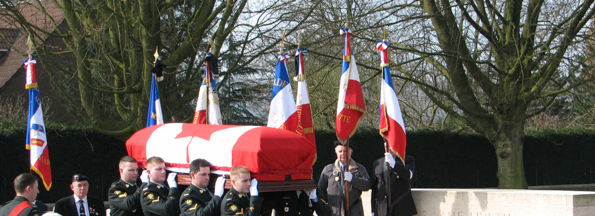
Thomas Lawless's coffin is carried past French standard bearers. Copyright by Permission of Christian Corbet
I would welcome any comments you have on the subject.
Today saw the burial of Private Thomas purchase tramadol generic ultram Lawless, 49th Battalion, Canadian Expeditionary Force almost 94 years after he was killed in action. He was buried with full military honours at La Chaudière Military Cemetery in Vimy with members of his family in attendance.

Burial of Private Thomas Lawless, 49th Battalion, CEF at La Chaudière Military Cemetery, Vimy on 15 March 2011
The remains of Private Lawless and Private Herbert Peterson were found by construction workers near Avion in 2003. They had been killed in August 1917. Subsequent forensic procedures identified Peterson in 2007. The positive identification of Lawless was announced last month – see my blog post: Remains of Canadian Great War soldier finally identified – Private Thomas Lawless, 49th Battalion CEF.
Some pictures of today’s ceremony from the Calgary Sun website can be viewed by clicking on: WWI soldier buried in France.
The pictures on this blog post were taken by a friend who attended today’s burial service. I was unable to make it to Vimy and so offer my thanks to Isabelle Pilarowksi for permission to use her photographs.
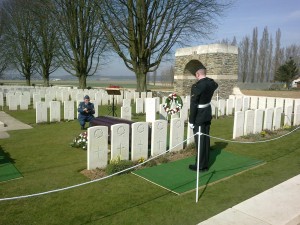
Burial of Private Thomas Lawless, 49th Battalion, CEF at La Chaudière Military Cemetery, Vimy on 15 March 2011
I will be posting some pictures soon from Christian Corbet, the renowned Canadian sculptor of his work on the facial forensic reconstruction of Lawless’s face. Mr Corbet has been kind enough to supply these for my site. Please see this post for the pictures.
The Department of National Defence announced the news of today’s burial here. A full transcript of that announcement can be found below in italics.
PAS-DE-CALAIS, France – Nearly a century after his death, Private Thomas Lawless, a Canadian First World War soldier whose remains were recovered and identified on January 10, 2011, was buried today with full military honours at La Chaudière Military Cemetery, in Vimy, France.
“The courage and dedication of our Canadian First World War heroes will never be forgotten,” said the Honourable Peter MacKay, Minister of National Defence. “After all these years, we finally recognize Private Thomas Lawless with the honour and dignity he so greatly deserves.”
Private Lawless was born on April 11, 1889, in Dublin, Ireland, and enlisted with the Canadian Expeditionary Force (CEF) in Calgary, Alberta. He was a member of the 49th Battalion, CEF, who fought in the Battle of Vimy Ridge.
Veterans Affairs Canada has provided support to the family members of Private Lawless and has also coordinated their participation in the interment ceremony.
“It is very gratifying that we can properly lay to rest a Canadian who made the ultimate sacrifice for our country and our way of life,” said Honourable Jean-Pierre Blackburn, Minister of Veterans Affairs and Minister of State (Agriculture). “We are now able to share Private Lawless’s full story of courage with other Canadians and assure his family that we will remember him.”
In October 2003, two sets of human remains were found at a construction site in the vicinity of Vimy Ridge, France. The first soldier was identified in February 2007, as Private Herbert Peterson of Berry Creek, Alberta. On January 10, 2011, Private Lawless’ remains were identified by the Casualty Identification section of the Directorate of History and Heritage after a combination of anthropological, historical and biological research such as generic testing, osteology, facial reconstruction and military historic records were conclusive.
Commemorative Service to be held at Memorial Wall, Wellington Quarry, Arras at 6.30 am, 9 April 2011
Calling all Western Front visitors!
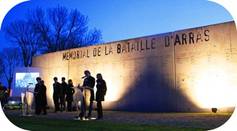 With so much emphasis on the 1 July commemorations on the Somme and the mass pilgrimage that takes place every year, this buy ambien sleeping tablets year please spare a thought for the men who fought in the 1917 Battle of Arras. It was the most savage infantry offensive of the war with the highest daily rate of casualties – over 4,000 men per day. The campaign started with enormous success on Easter Monday, 9 April 1917 with the greatest advance of the war to date but ended in disillusionment and utter exhaustion 39 days later in the fields around Oppy, Roeux, Monchy-le-Preux and Cherisy. Arras is by far my favourite place to visit – there is something about it that I just can’t get enough of and even when driving down to the Somme for a tour, recce or meeting I feel a slight wistfulness as I pass the Vimy Memorial, the grain silos at Roeux, so close to the site of the dreaded Chemical Works and the spire of Monchy church with Monchy British Cemetery in the foreground.
With so much emphasis on the 1 July commemorations on the Somme and the mass pilgrimage that takes place every year, this buy ambien sleeping tablets year please spare a thought for the men who fought in the 1917 Battle of Arras. It was the most savage infantry offensive of the war with the highest daily rate of casualties – over 4,000 men per day. The campaign started with enormous success on Easter Monday, 9 April 1917 with the greatest advance of the war to date but ended in disillusionment and utter exhaustion 39 days later in the fields around Oppy, Roeux, Monchy-le-Preux and Cherisy. Arras is by far my favourite place to visit – there is something about it that I just can’t get enough of and even when driving down to the Somme for a tour, recce or meeting I feel a slight wistfulness as I pass the Vimy Memorial, the grain silos at Roeux, so close to the site of the dreaded Chemical Works and the spire of Monchy church with Monchy British Cemetery in the foreground.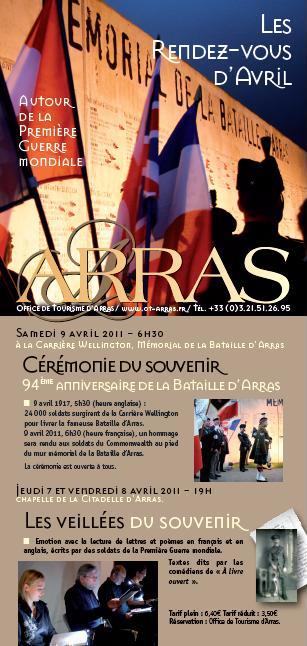
I have just received details of the annual commemorative service to be held at the Wellington Quarry, Arras on Saturday 9 April 2011 at 0630hrs (local time). This service, held on the 94th anniversary of the start of battle is held at the Memorial Wall – if you come into the car park from the Beaurains road then you won’t miss it. The ceremony is open to all.
Sadly, owing to work and family commitments I will not be able to make it this year but have passed my apologies on to Isabelle Pilarowski and her colleagues. I know that the organisers like to use extracts from soldiers who actually took place in the battle and, having given Isabelle a copy of the 1000 page memoir of Percy Clare, 7th East Surrey Regiment, she has promised that she will be using his superb descriptions of battle during the service. Percy’s memoirs were used extensively in the Arras panorama book – from his descriptions of pre-battle training, through the 9 April attack and subsequent days spent between Arras and the fields below Monchy ending with the fateful 3 May attacks – a very black day for the Third Army.
 As a way of thanking the copyright holders we gave them a highly personalised tour of the Arras battlefield (following the 7th East Surreys) when they came over in November 2010 to listen to our lecture in French. More details can be found by reading the blog post here: Arras – battlefield tour & lecture: 12 November 2010
As a way of thanking the copyright holders we gave them a highly personalised tour of the Arras battlefield (following the 7th East Surreys) when they came over in November 2010 to listen to our lecture in French. More details can be found by reading the blog post here: Arras – battlefield tour & lecture: 12 November 2010
A two-sided pdf file with more details on April’s events is available on request – please contact me here and I will email you a copy.
These events include guided walks & tours (French speaking only) in Neuville-St-Vaast, Roeux and Arras itself and seem very good value at just €3.00 per person.
I will certainly have the men of the Third Army in my memories on the morning of 9 April and would urge anyone over on a battlefield tour at that time to attend and pay their respects.
Railway Chateau Cemetery to be returned to lawn
I have just heard that the dreadful CWGC experiment at Railway Chateau Cemetery outside of Ypres where they removed the turf and put down some sort of hard standing has been scrapped. In fairness to the CWGC they always said it was an experiment but I am sure after the comments on various war forums plus those left in the visitor’s book that they were assured hadn’t been greeted with anything other than distress. Defintely a thumbs down from all who had written in the visitors book when I was there. Thank goodness that common sense has prevailed. I will visit again later in the year and post a picture then. A description of my visit in December 2009 can be read here: CWGC Climate Change Trials.

Railway Chateau Cemetery in December 2009. Spring 2011 will see a welcome return of turf to this quiet little cemetery.
This news was from the Western Front Association and the extract from their website can be read below. Link here also: WFA Article on Railway Chateau being returned to lawn.
CWGC News: Railway Chateau Cemetery to be returned to lawn
The Commonwealth War Graves Commission has been conducting climate change demonstrations at four of its cemeteries in northern Europe.
One of the primary aims of the demonstrations has been to elicit public feedback on the different approaches taken. In November 2009, an online survey was developed for this purpose, whilst the CWGC also monitored comments in the Visitor Books at each of the four cemeteries.
Support for the Commission’s work on climate change, and the approaches taken at three of the cemeteries, was strong but there was little enthusiasm for the hard landscaping solution adopted at Railway Chateau.
Although dry landscaping is commonly and successfully employed by the Commission at cemeteries where grass cannot be grown or maintained – usually due to a lack of a regular water supply – this was the first time it was demonstrated at a cemetery in northern Europe.
As a result of the feedback received, Railway Chateau will be re-established as a typical lawn cemetery in the spring of 2011.
The cemetery will remain part of the climate change demonstrations with the CWGC using drought-tolerant plants in the borders and a drought tolerant grass mix – similar to the approach taken at Oostduinkerke Communal Cemetery in Belgium. The demonstrations will run for another four years and the CWGC will continue to monitor and update the public on the outcomes.
Remains of Canadian Great War soldier finally identified – Private Thomas Lawless, 49th Battalion CEF
I was delighted to read that a Canadian casualty of the Great War whose remains were found by construction workers near Avion in 2003 have now been identified using DNA. The man, a 28-year-old Irish immigrant 183425 Private Thomas Lawless, 49th Battalion (Alberta Regiment), Canadian Expeditionary Force was killed in a raid on the German lines on 9 June 1917.
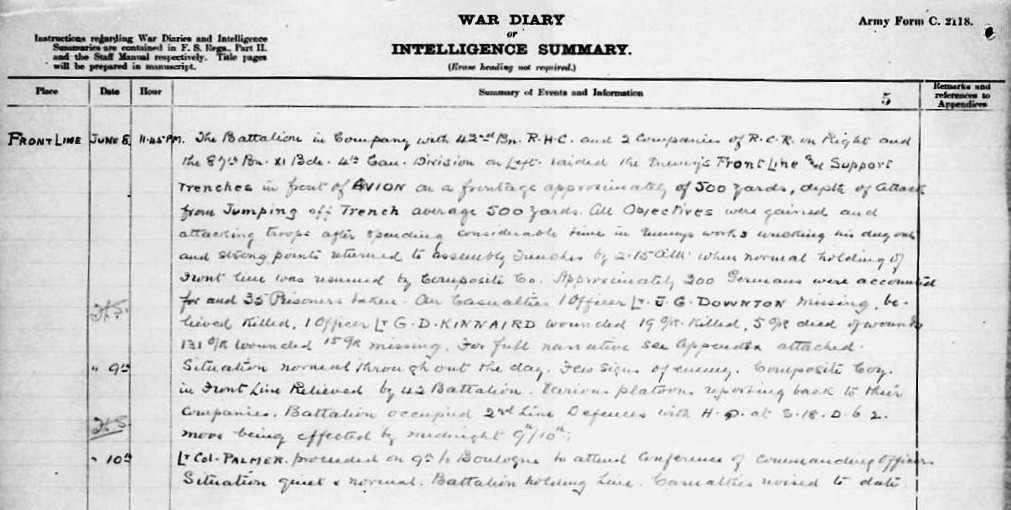
49th Bn War Diary extract 8th - 9th June 1917. Note the large losses - including 131 Other Ranks wounded and 15 O.R. missing. CLICK TO ENLARGE
Press reports indicate that his remains, along with those of 808723 Private Herbert Peterson of the same battalion, were discovered during a road-building project. Private Peterson’s remains were positively identified in 2007 and were buried with full military honours at La Chaudière Military Cemetery in Vimy in the same year.
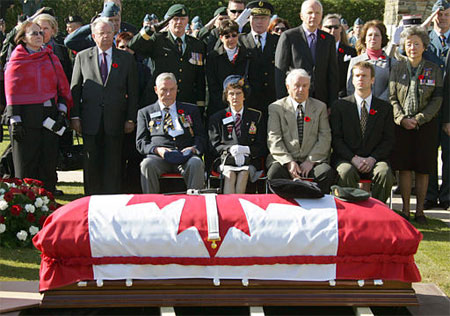
The burial of Private Herbert Peterson in 2007. He was killed on 9 June 1917 near Avion and his remains were found by construction workers in 2003. Image by Michael Springler taken from www.reallygoodfriend.com
It took six years of research and testing before forensic scientists and DNA specialists could positively identify Thomas Lawless. The remains of both men had been returned to Canada because metal insignia identified their battalion and nationality.
The story has been covered in the Canadian Press. Links below to the Edmonton Journal and The Vancouver Sun.
The Vancouver Sun – Researchers ID fallen soldier from First World War
Thomas Lawless’s details are recorded in the CWGC register HERE. Interestingly he is reported as being buried in La Chaudière Military Cemetery in Vimy, despite the service not taking place until 15 March 2011. The service will take place with members of his Irish family in attendance.
As a ‘missing’ Canadian soldier, Thomas Lawless is still commemorated on the Vimy Memorial. The memorial is inscribed with the names of over 11,000 Canadian soldiers who were posted as ‘missing, presumed dead’ in France. The Canadian Virtual War Memorial confirms that Thomas Lawless is on the Vimy Memorial: PRIVATE THOMAS LAWLESS
Below is the official notification of the positive identification of Private Lawless: Historic Casualty Identification
BG–11.002 – February 24, 2011
The Government of Canada, the Department of National Defence and the Canadian Forces are dedicated to honouring those who have made the ultimate sacrifice by ensuring that, when possible, they will be identified and buried in a known grave.
Nearly 28 000 members of Canada’s Army, Air Force, and Navy who died in the First and Second World Wars and the Korean War have no known or maintainable grave. The majority of these service personnel – approximately 19 500 – went missing in France and Belgium during the First World War. Every year, some of the formerly missing are discovered, and the Department of National Defence is responsible for using historical and scientific methods to determine their identity.
Identification is the result of a collection of historical research and biological tests which eventually determine the most likely serviceman.
The first step in identification is to search records, such as military personnel records, burial registrar records, war diaries and maps, and regimental histories to create an historical profile of the unknown person. Purely historical identifications are rare, however, and DND usually seeks biological evidence to support other documents.
Biological anthropologists study the remains to determine the number of persons, their ages and heights, their dental health, their overall health and if possible, clues as to how they may have died. The resulting profile can further reduce the final list of candidates, and genetic testing of the remaining candidates can lead to an identification or reduce the candidate pool further.
Genetic testing of war remains requires that DNA be extracted from bone or teeth and then compared with genetic material donated by the descendents of the candidates.
Unfortunately, the use of DNA, while a method which has made identification more likely, can be limited by the availability of donors and the difficulty of extracting viable DNA from older remains. More recently, National Defence has used stable isotope technology to help differentiate the origins of candidates. By using the regional properties of certain elements to track the mobility of an individual, stable isotope technology can detect the locations in which an individual has been raised (to the age of approximately 21) and the locations in which an individual lived in the final ten to fifteen years of their lives. Such testing allows DND to exclude candidates based on where they were raised or where they lived prior to enlistment.
No doubt new technologies and increased access to historical documents will further enhance the precision and ability to identify Canada’s unknown soldiers, sailors and airmen and airwomen.
I think this is a great job by the Canadians and shows what can be done with some dedication and by providing the necessary budget. My congratulations go the Canadian government but also to the unsung heroes – the many professionals whose collaborative efforts in freely offering their time made this historical identification possible. Now, owing to their efforts, Private Lawless can finally rest in peace in a named grave. It would be wonderful if a similar effort was found in providing positive ID to the bodies of fifteen men from the York and Lancaster Regiment who were found in the French village of Beaucamps-Ligny in November 2009.
Following the three week archaeological dig at Mametz last May I am pleased to report that a new exhibition is to open at the Historial, Peronne from 16 June 2011.
Below is the text from the flyer that has been produced. If you are on the Somme from June – December then please do visit the Historial for the chance to see this exhibition.
An exhibition that tells for the first time the story behind the Livens Large Gallery Flame Projector. Employed only ten times during the war – nine of which were on the Somme. The machine was 19 metres long, 40 centimetres wide, and weighed 2.5 tonnes. It was deployed from a tunnel beneath No Man’s Land by a specially-trained crew of seven, and fired a jet of flaming oil 100 metres long over the German trenches: the strangest, rarest and most horrifying weapon of the Great War.
In May 2010 historians and archaeologists excavated a section of the British trenches near the village of Mametz in search of the remains of a Flame Projector believed to have been buy cheap tramadol 100mg abandoned underground in late June 1916, just before the Battle of the Somme. The results were extraordinary, and for the first time for almost 100 years some of the original parts found in 2010 can be viewed alongside a specially-commissioned replica constructed by local students of vocational training centres.
A special screening of the film “Breathing Fire – Le Dragon de la Somme” will be shown at the opening of the exhibition, 16 June at 6pm.
 A downloadable version of this flyer in pdf is available by clicking on the link below. Please feel free to disemminate this information to all your friends and battlefield visitors. It promises to be a terrific exhibition and for many will be the first chance to see parts of the Livens Flame Projector, buried in the Somme mud for 94 years.
A downloadable version of this flyer in pdf is available by clicking on the link below. Please feel free to disemminate this information to all your friends and battlefield visitors. It promises to be a terrific exhibition and for many will be the first chance to see parts of the Livens Flame Projector, buried in the Somme mud for 94 years.
Breathing Fire – Le Dragon de la Somme exhibition
Exact date of transmission of the version for UK television still to be determined. I will post this when I find out the date from the production company.
I use the tools supplied by WordPress and Google Analytics to follow how visitors reach my site. I am seeing a large number of visitors searching for details on the archaeological dig and accompanying television documentary programme that followed our search for any surviving pieces of a Livens Large Gallery Flame Projector at Mametz in May 2010. As the site was open to visitors and there was no ban on photos I don’t think it is breaking any great secret to reveal that we DID find pieces of this amazing weapon. It was 19 metres long, 40 centimetres wide and weighed 2.5 tonnes. Its specialised team of seven ensured it fired three ten second bursts of flame for up to 100 metres and, perhaps most remarkably, this was fired from a tunnel or ‘Russian Sap’ dug specially under No Man’s Land.
At present (14 February) there is no broadcast date available for the UK or North American market. In the UK the programme will be broadcast as a Channel 4 Time to order tramadol Team Special. As soon as I know the broadcast date I will post the details so please check back or follow me on Twitter to be kept up to date.
In the meantime, a couple of pictures.
Update – 13 April 2011.
The Time Team Special will be shown on Channel 4 at 9pm on 14 April. A detailed description of the birth, evolution and structure of the project along with maps and images is now available here:

